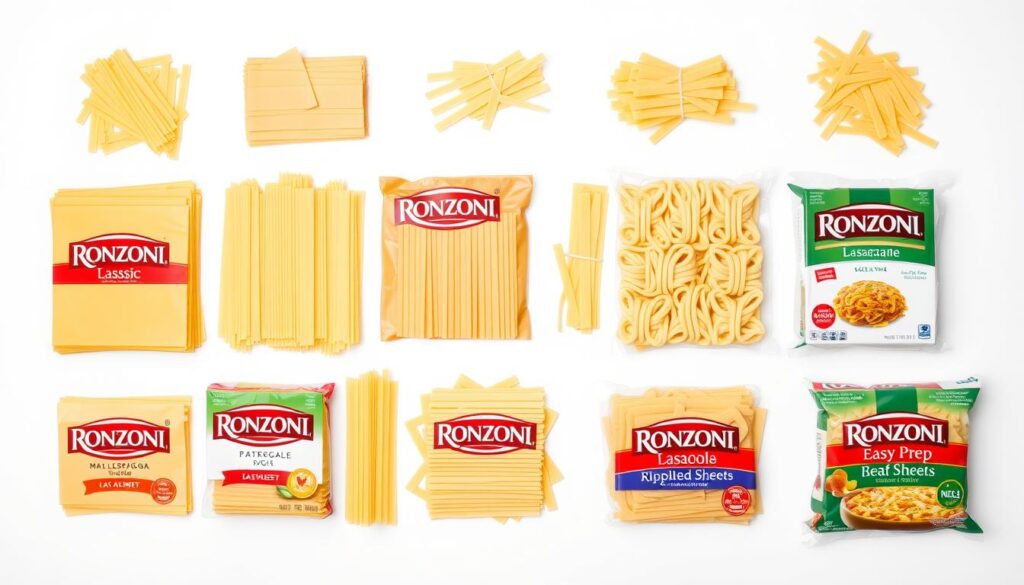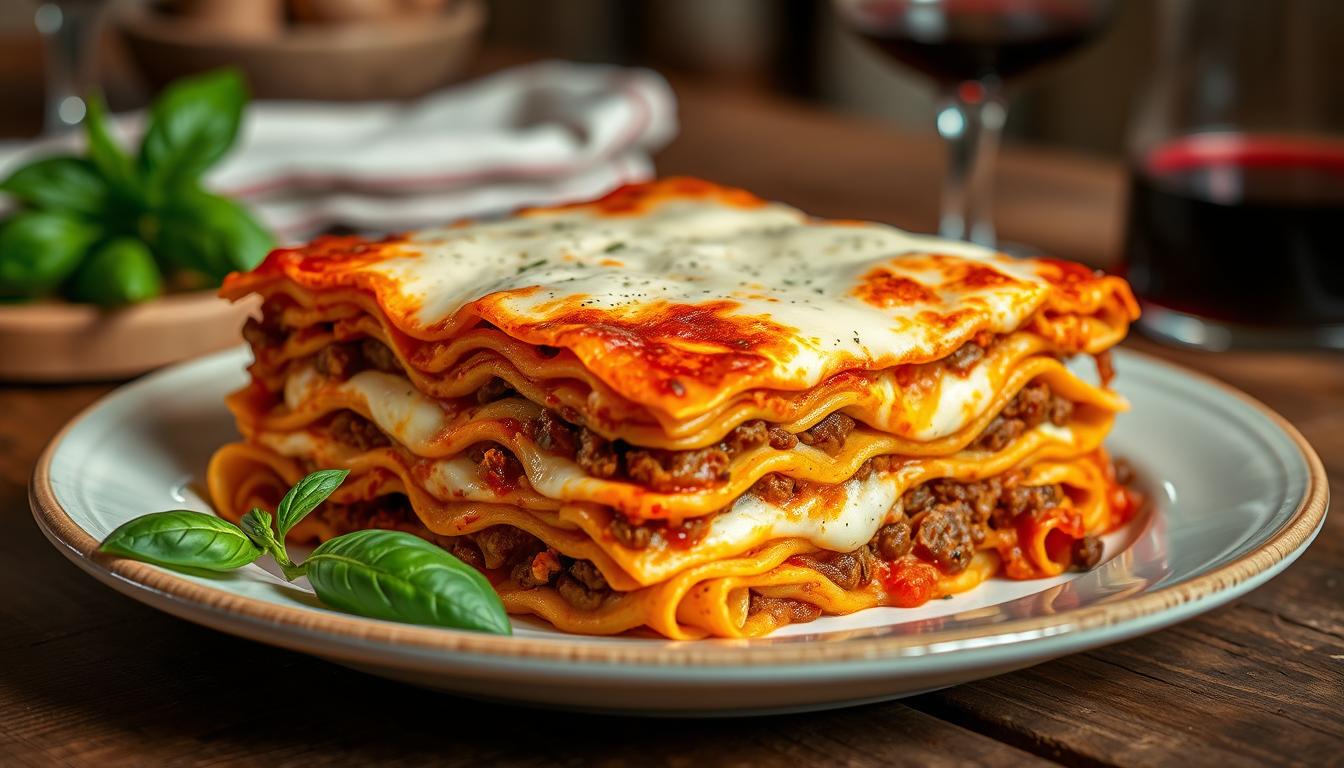Winter is the perfect time to dive into the warm world of Ronzoni lasagna. This classic Italian dish turns simple ingredients into a meal that warms your heart. It’s all about layering flavors and textures to create something special.
The Ronzoni lasagna recipe is more than just a meal. It’s a way to connect with traditional Italian cooking. It’s perfect for home cooks who love hearty, satisfying dishes. This recipe makes your winter meals more flavorful with little effort.
Key Takeaways
- Perfect for cozy winter meal preparation
- Uses convenient oven-ready lasagna sheets
- Combines three distinctive cheese varieties
- Quick and simple assembly process
- Serves approximately 8 people
- Nutritionally balanced dinner option
Understanding the Classic Italian Lasagna Heritage
Lasagna is more than a tasty meal; it’s a journey through Italian food history. It starts in ancient Rome, where layered pasta dishes first caught people’s attention.
The story of lasagna’s growth is filled with creativity. Ancient Romans made early versions of layered dishes. These dishes evolved into the lasagna we love today. Pasta makers like Ronzoni helped bring this dish to American homes.
Origins of Traditional Lasagna
Exploring lasagna’s beginnings offers interesting historical facts:
- It comes from the Emilia-Romagna region of Italy
- First recipes were in the Middle Ages
- It was once for the rich only
- Now, it’s a common dish in Italian homes
Evolution of Modern Lasagna Making
Traditional methods changed with new technology. Home cooks started trying new ingredients. This led to many regional lasagna styles.
Why Ronzoni Became a Household Name
Ronzoni changed lasagna noodles for American cooks. Their quality and easy access made Italian food more accessible in the U.S.
Lasagna: A delicious bridge between traditional Italian cooking and modern culinary innovation.
Essential Ingredients for Your Lasagna
Creating the perfect lasagna starts with choosing top-notch ingredients. These ingredients turn your dish into a true Italian classic. Your lasagna noodles are the base, and no-cook varieties save you time.
Now, let’s explore the key ingredients that make your lasagna stand out:
- Lasagna Noodles: Pick premium brands like Flora or Rummo for the best taste
- Protein: Mix ground beef and hot Italian sausage for a deep flavor
- Cheeses:
- Ricotta cheese (15 ounces of whole-milk variety)
- Mozzarella cheese (3 cups of part-skim, shredded)
- Parmesan cheese (1 cup, freshly grated)
- Herbs and Seasonings: Use fresh parsley, dried herbs, salt, and pepper
The secret to a great lasagna is the ricotta cheese. Whole-milk ricotta adds a creamy texture that complements the meat sauce. For mozzarella, choose part-skim varieties for a smooth melt and golden layers.
Pro tip: Use fresh ingredients and layer your lasagna with care. The right mix of noodles, cheeses, and sauce makes a meal that everyone will love.
Ronzoni Lasagna Recipe: Master the Perfect Layers
Making a great ronzoni lasagna recipe takes skill and love. It’s all about getting each part right and how they blend together. This makes a true Italian classic.
Three key things make your lasagna stand out: the meat sauce, ricotta cheese mix, and how you layer it. Let’s look at each part to make sure your lasagna is perfect.
Preparing the Meat Sauce
A great lasagna starts with a rich tomato sauce. Begin with top-notch ground beef or a mix of beef and Italian sausage. Here are the must-haves:
- Fresh ground beef
- Diced onions
- Minced garlic
- Crushed tomatoes
- Dried Italian herbs
Creating the Ricotta Mixture
The ricotta cheese mix adds creaminess and flavor. Mix these for the best taste:
| Ingredient | Quantity |
|---|---|
| Ricotta cheese | 15 oz |
| Eggs | 2 large |
| Parmesan cheese | 1/2 cup |
| Fresh parsley | 2 tbsp |
Layering Techniques for Best Results
Layering right makes your lasagna amazing. Follow these steps for the best results:
- Start with a thin layer of tomato sauce on the bottom of the baking dish
- Place Ronzoni lasagna noodles in a single layer
- Spread ricotta mixture evenly
- Add meat sauce
- Sprinkle mozzarella cheese
- Repeat layers
Pro tip: Always cover your lasagna with foil during initial baking to retain moisture and prevent burning.
Choosing the Right Pasta Sheets

Choosing the right lasagna noodles is crucial for your Ronzoni lasagna recipe. Ronzoni offers two main options. These cater to different cooking styles and time needs.
Traditional vs. Oven-Ready Lasagna Noodles
When making lasagna noodles, you have two main choices:
- Traditional Lasagna Noodles: Need boiling before you start
- Oven-Ready Lasagna Noodles: Skip the boiling, save time
Traditional noodles boil for 8-10 minutes to get the right feel. Oven-ready sheets cut out this step, making cooking easier.
Noodle Selection Tips
To get the best out of your Ronzoni lasagna recipe, keep these tips in mind:
- Always check the package instructions
- Think about how much time you have
- Choose the texture you like best
| Noodle Type | Preparation Time | Cooking Complexity |
|---|---|---|
| Traditional Lasagna Noodles | 10-12 minutes | Moderate |
| Oven-Ready Lasagna Noodles | 0 minutes | Easy |
Pro tip: For gluten-free options, cook a bit less to avoid overcooking. Your lasagna noodle choice affects the dish’s texture and taste.
Mastering the Cheese Combinations
Making the perfect lasagna is all about the cheese. The right mix can turn a simple dish into a masterpiece. Knowing how cheeses work together is key to a memorable meal.
Types of Cheese to Use
Choosing the right cheeses is essential for a great lasagna. You’ll need a mix of:
- Ricotta cheese: It adds creaminess and flavor
- Mozzarella cheese: This gives the dish its stretchy, melty feel
- Parmesan cheese: It brings a sharp, nutty taste
Proper Ratios for Balanced Flavor
| Cheese Type | Recommended Amount | Calorie Content |
|---|---|---|
| Ricotta | 15 ounces | 171 calories (part-skim) |
| Mozzarella | 2 cups | 72 calories per ounce |
| Parmesan | 1/2 cup | 22 calories per tablespoon |
Melting Techniques for Perfect Texture
To get the cheese just right, mix ricotta with egg and spices. This makes a smooth base. Then, layer mozzarella to melt evenly. Top with Parmesan for a crispy, golden crust.
Pro tip: Let your lasagna rest for 15 minutes after baking. This allows the cheese to set and makes slicing much easier. Your patience will be rewarded with picture-perfect lasagna layers that hold together beautifully.
Preparing the Perfect Sauce Base
Making a great tomato sauce is key to a delicious lasagna. Your sauce should be rich, flavorful, and full of herbs like basil and garlic. Choosing the right ingredients and cooking technique are crucial.
Begin by picking the best tomatoes for your sauce. San Marzano tomatoes are perfect, with their sweet and strong flavor. Here are important steps for your tomato sauce:
- Crush fresh tomatoes by hand for authentic texture
- Sauté minced garlic in olive oil until fragrant
- Add fresh basil leaves for an aromatic touch
- Simmer sauce slowly to develop deep flavors
Experts say to simmer your tomato sauce for 90-120 minutes. This slow cooking lets garlic and basil blend into the sauce. It makes the sauce rich and complex.
| Ingredient | Quantity | Purpose |
|---|---|---|
| San Marzano Tomatoes | 28 oz | Base of sauce |
| Fresh Garlic | 4-5 cloves | Aromatic flavor |
| Fresh Basil | 1/4 cup | Herbal notes |
| Olive Oil | 2 tablespoons | Sautéing and flavor |
If you’re short on time, you can also use store-bought tomato sauce. Just add fresh garlic, torn basil leaves, and olive oil. It will make your sauce taste much better.
For additional recipes ideas, check out The Ultimate Guide to Capellini Pasta
Assembly and Baking Instructions
Making the perfect baked pasta dish needs careful steps and baking skills. Your Ronzoni lasagna will turn into a delicious meal with the right steps.
Layer Order Guide
Building your lasagna is like an art that needs focus. Here’s how to layer it:
- Begin with a thin layer of meat sauce at the bottom of your 9×13 inch baking dish
- Put the first layer of Ronzoni pasta sheets
- Spread a lot of ricotta mixture
- Add meat sauce evenly
- Sprinkle mozzarella and Parmesan mix
- Repeat layers 3-4 times
Temperature and Timing Tips
Getting the temperature right is key for your baked pasta. Bake your Ronzoni lasagna recipe at 375°F (190°C). Follow these steps:
- Cover with foil for the first 25-30 minutes
- Uncover and bake for another 35-45 minutes
- Let it cool for 20-30 minutes before serving
Visual Cues for Doneness
Your lasagna is done when you see:
- Golden-brown cheese top
- Bubbling edges
- Slight pulling away from the baking dish sides
- Internal temperature reaches 165°F
Storage and Make-Ahead Options

Planning ahead can make your lasagna experience better. This baked pasta dish is great for meal prep and storage. It’s perfect for busy families or special events, knowing how to store it is key.
Refrigerate your lasagna for up to 5 days. Use airtight containers or wrap it tightly with plastic and foil. This keeps it moist and safe from contamination.
Freezing Options
Freezing your lasagna makes it even more convenient. You have two main ways:
- Freeze cooked lasagna slices for up to 3 months
- Freeze an entire unbaked baked pasta dish for future meals
For the best freezing results, follow these steps:
- Cool the lasagna completely before freezing
- Wrap tightly in freezer-safe packaging
- Label with the date of preparation
- Thaw in the refrigerator for 24 hours before reheating
Pro tip: When reheating frozen lasagna, cover with foil and bake at 375°F. Unbaked dishes will require approximately 1.5 hours of total cooking time.
The key to preserving your lasagna’s delicious flavor is proper storage and careful reheating.
Make-ahead strategies can save you a lot of time. You can prep the whole dish up to 3 days in advance and refrigerate before baking. This is great for busy weeknights or when hosting guests.
Variations and Creative Twists
Italian cuisine is all about flexibility, especially with dishes like lasagna. You can make changes to fit dietary needs or just to try something new. These creative twists will give your baked pasta dish a fresh spin.
Trying out different lasagna styles lets you make this classic dish your own. You can keep the recipe’s core while exploring new flavors and textures. Let’s look at some exciting changes that cater to various tastes and dietary needs.
Vegetarian Alternatives
Make a tasty meat-free lasagna by swapping ground beef for plant-based proteins. Here are some great options:
- Roasted vegetable layers with zucchini, eggplant, and bell peppers
- Crumbled tofu seasoned with Italian herbs
- Lentil and mushroom mixture for a hearty texture
- Spinach and ricotta cheese filling
Gluten-Free Options
If you’re gluten-sensitive, there are many ways to keep your dish tasting authentic:
- Use gluten-free lasagna noodles made from rice or corn
- Replace traditional wheat pasta with zucchini or eggplant layers
- Ensure all sauce ingredients are certified gluten-free
Spice Level Adjustments
Adjust the heat to your liking by trying different spice levels:
- Mild version: Reduce or eliminate red pepper flakes
- Medium heat: Add ½ teaspoon red pepper flakes
- Spicy version: Incorporate hot Italian sausage or jalapeños
The charm of Italian cuisine is in its ability to adapt. Feel free to get creative and make the recipe your own!
Serving and Presentation Tips
When you serve your Ronzoni lasagna, how it looks is just as important as how it tastes. Cut clean, precise slices after letting the dish rest for 15-20 minutes. This step helps the layers set, making each slice look perfect on the plate.
Pair your lasagna with classic sides to enhance its flavors. A crisp green salad with a light vinaigrette is a great choice. Garlic bread is also excellent, offering a crunchy contrast to the lasagna’s soft layers. Serve chilled white wines like Pinot Grigio or sparkling water to refresh your palate.
For a fancy presentation, use a white ceramic dish to show off the lasagna’s golden-brown top. Add fresh basil leaves or a sprinkle of Parmesan cheese for color and depth. Remember, plating is an art – take your time to make a meal that looks as good as it tastes.
With these serving tips, your lasagna can go from a simple family meal to a stunning dinner party centerpiece. The secret is to pay as much attention to presentation as you do to preparing each layer.
FAQ
How long does it take to prepare a Ronzoni lasagna?
Preparing a Ronzoni lasagna takes about 1-1.5 hours. This includes both preparation and baking. The prep work usually takes 30-45 minutes. Baking time is 45-60 minutes, depending on your recipe and oven.
Can I make lasagna ahead of time?
Yes, you can! Assemble the lasagna up to 24 hours in advance. Store it covered in the fridge. When ready, bake it straight from the fridge, adding 15 minutes to the time.
What’s the best way to store leftover lasagna?
Store leftover lasagna in an airtight container in the fridge for 3-5 days. Reheat it covered in foil at 350°F until warm. This keeps it moist and prevents drying.
Can I freeze Ronzoni lasagna?
Yes, lasagna freezes well. You can freeze it before or after baking. Wrap it tightly in plastic wrap and foil if freezing before. After baking, let it cool and then wrap it. It lasts up to 3 months in the freezer.
Are there gluten-free options for lasagna noodles?
Yes, many brands offer gluten-free lasagna noodles. They’re made from rice, corn, or quinoa. You can also use zucchini or eggplant slices for a low-carb option.
How can I make a vegetarian lasagna using Ronzoni noodles?
Use sautéed vegetables like zucchini, spinach, mushrooms, and bell peppers instead of meat sauce. Mix in ricotta and mozzarella cheeses. Add tofu or lentils for extra protein.
What’s the best cheese combination for lasagna?
Use ricotta for creaminess, mozzarella for stretch, and Parmesan for flavor. A good mix is 2 cups ricotta, 2 cups mozzarella, and 1/2 cup Parmesan for a 9×13 inch lasagna.
How do I prevent my lasagna from becoming watery?
To avoid excess moisture, drain ricotta in cheesecloth. Use less watery tomato sauce. Let the lasagna rest for 15-20 minutes after baking. This helps absorb liquid and makes cutting easier.

